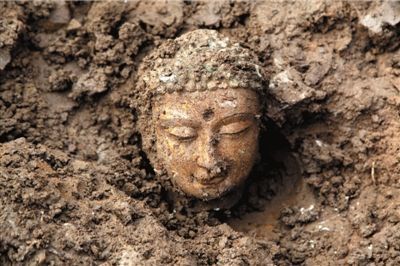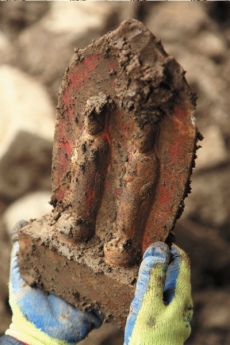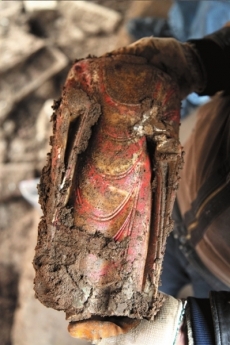NEWS
Museum Exhibiting 200 Ancient Buddhist Statues to Open in Hebei
A museum exhibiting more than 200 rare Buddhist statues and statue fragments is scheduled to open in Linzhang County in the northeastern Chinese province of Hebei in October. Museum executive Liu Haitao noted that some of the pieces are around 1,500 years old.
The exhibits have been selected from among almost 3,000 complete statues and fragments unearthed in January 2012 at the site of Yecheng, a 2,500-year-old city. Most can be dated to the Eastern Wei (534–50) or Northern Qi (550–77) dynasty and are made of white marble and blue stone, some with the original painting or gilding remaining.
According to Zhang Wenrui, an official with the Hebei Provincial Bureau of Cultural Heritage, the statues range from 20 centimeters to life size, and are notable for both their quantity and quality.

A partially excavated statue of the Buddha at the historic site in
Hebei Province. From english.cri.cn
The ancient city of Yecheng, also known as Ye, was located in what is now Linzhang County in Hebei and in neighboring Anyang in Henan Province, and was established during the Spring and Autumn Period (c. 771–476 BCE). In the last years of the Eastern Han dynasty in the 3rd century CE, the city served as the military headquarters of the warlords Yuan Shao and Cao Cao, and from 220–589, became a major political and economic center.
The 2,895 Buddha statues and statue fragments were excavated by a team of archaeologists from the Chinese Academy of Social Sciences (CASS) and the Hebei Provincial Institute of Cultural Heritage, and according to team member He Liqun, were found in a pit about 13 feet wide and 16 feet deep. An archaeologist with the Institute of Archaeology under CASS said that the discovery was the largest of its kind in the country since the founding of the People’s Republic of China in 1949.
A Xinhua report at the time revealed that the Cultural Relics Bureau of Linzhang County had signed a letter of intent with a local company to invest 10 billion yuan (US$1.6 billion) to construct a Buddhist cultural park in the area. Expected to cover some 264 acres, the park would provide archaeological research opportunities and a venue to protect and exhibit the ancient Buddhist relics. In addition to the museum, the project plan includes a Buddhist school, temples, and Buddha statues, as well as hotels and shopping facilities. The report did not detail when construction was scheduled to start or how long the project would take.
 One of the sculptures unearthed in Hebei. From china.org.cn
One of the sculptures unearthed in Hebei. From china.org.cn An artifact from the excavation in Hebei. From china.org.cn
An artifact from the excavation in Hebei. From china.org.cnIntroduced to China from India, Buddhism became increasingly popular during the Eastern Wei and Northern Qi dynasties, when Yecheng served as China’s capital. The religion was especially prevalent during the Northern Qi dynasty; the imperial family is reported to have been devoutly Buddhist, and more than one seventh of the kingdom’s population is believed to have taken monastic ordination. According to historical accounts, there were about 30,000 temples in the country at the time, and roughly 2 million monks and nuns, with some 4,000 temples and nearly 80,000 monastics in Yecheng itself.
See more
Ancient Buddhist statues to go on show (Shanghai Daily)
China to open museum with rare Buddhists statues in Hebei (The Economic Times)
Thousands of Ancient Buddha Statues Unearthed in N China (CRIENGLISH.com)














